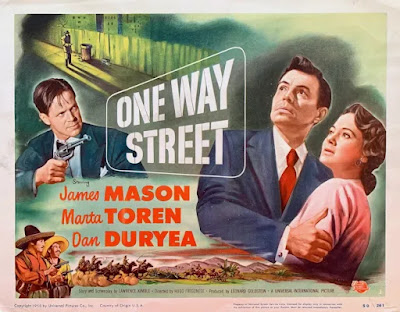This is a fun way to spend sixty minutes with one of the most abrupt endings in B-moviedom. The story moves along in tidy fashion, leaving much of the 35mm film on the cutting room floor, yet it will task your suspended disbelief sensibilities. Standard night scenes of the era were created with filters along with limited use of studio backdrop driving scenery. There is a fair share of location filming however and one brief chase scene for the auto and highway patrol motorcycle enthusiast.
Penny Edwards plays this title character. We have no background on the character other than she and her husband are on their honeymoon. Their auto is hijacked by two car thieves, James Millican and John Alvin with the former putting a slug in the gallant husband and with a blow to the head, she falls forward on the steering wheel. The depressed horn continues, signaling local officers patrolling the area. Her character then becomes implausibly polished to pull off the potentially deadly scheme she has in mind. Maybe she was a former FBI agent.
While being questioned by the local authorities, Edwards gets the idea to go undercover to locate the killer of her husband and report his location to the police. She is very savvy about this sort of thing and certainly knows how to bamboozle everyone. All we know is she has experience utilizing a fake persona. Five years on Broadway, perhaps. Her assumed photographic memory comes into play as she only briefly reads a prisoner’s rap sheet but has all the details down pat. Apparently, women come in handy as a distraction during a car heist, so she goes from brunette to Edward’s natural blonde hair, nearly a complete reversal of television’s Richard Kimball. She rolls with every conversation like a pro. One is unsure at what point she will feel in over her head with this charade, but you know it is coming.
She gets the honor of meeting Robert Shayne, the boss of the chopshop. In an awkward scene, after she is driven to the shop location to look around and meet all the nice fellows, Alvin bids her goodbye, until later. She walks out the side door and I wonder where she is going. She has no car. She has no place of her own. I imagine her suddenly stopping in the alley and telling herself, "Dumb, dumb, dumb, now I've done it!" The director must have dozed off during the dailies.
As usual, there are more bits of unintentionally funny scenes for twenty-first-century replays. Bureau of Missing Persons officer, James Brown, gets a tip on Edward’s whereabouts but it is so screwy, her being undercover and all, he tells his superior he might as well file it in the trash can. The superior, in a serious reply, “Never file anything in the trash can.” Oh...right chief. And another: Edwards knew one thief by the name of Hans and with that to go on the superior officer writes down “Hands” on the backboard. He spends countless hours trying to make sense of the nickname and make a connection with it. James Brown enters the room and erases the “D” and suddenly the mystery is solved.
Police locate Edwards and she begs to go back and help round up Shayne and Gang. They seem to think it is quite dangerous to return but tell her to try and stay alive. Bolstered with that encouragement, her missing person’s reward poster is spotted by Alvin and her undercover work appears to be coming to an end. What we learn is that everyone in a chop shop carries a gun. The ending shootout with police includes the trademark Republic Pictures gun sound from their many westerns. And then the film ends abruptly. The director looked at his watch and announced we are done here, people. Edwards transitions to television in the 1960s and retires. Abruptly.
She gets the honor of meeting Robert Shayne, the boss of the chopshop. In an awkward scene, after she is driven to the shop location to look around and meet all the nice fellows, Alvin bids her goodbye, until later. She walks out the side door and I wonder where she is going. She has no car. She has no place of her own. I imagine her suddenly stopping in the alley and telling herself, "Dumb, dumb, dumb, now I've done it!" The director must have dozed off during the dailies.
As usual, there are more bits of unintentionally funny scenes for twenty-first-century replays. Bureau of Missing Persons officer, James Brown, gets a tip on Edward’s whereabouts but it is so screwy, her being undercover and all, he tells his superior he might as well file it in the trash can. The superior, in a serious reply, “Never file anything in the trash can.” Oh...right chief. And another: Edwards knew one thief by the name of Hans and with that to go on the superior officer writes down “Hands” on the backboard. He spends countless hours trying to make sense of the nickname and make a connection with it. James Brown enters the room and erases the “D” and suddenly the mystery is solved.
Police locate Edwards and she begs to go back and help round up Shayne and Gang. They seem to think it is quite dangerous to return but tell her to try and stay alive. Bolstered with that encouragement, her missing person’s reward poster is spotted by Alvin and her undercover work appears to be coming to an end. What we learn is that everyone in a chop shop carries a gun. The ending shootout with police includes the trademark Republic Pictures gun sound from their many westerns. And then the film ends abruptly. The director looked at his watch and announced we are done here, people. Edwards transitions to television in the 1960s and retires. Abruptly.










